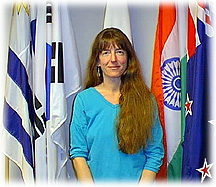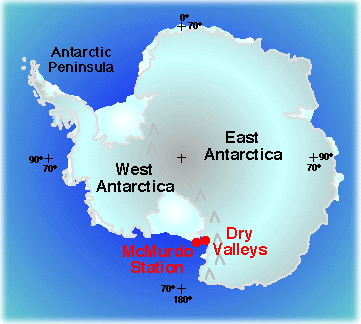
|


Each year, I try to have at least one big adventure. Antarctica will top
them all! One of the many benefits of teaching are all the wonderful
opportunities for learning. This was the third summer since 1996 that I've
been a full time student. I took a Marine Algae and Phytoplankton class at
the Friday Harbor Labs to get prepared for my research experience in the
McMurdo Dry Valleys. Last year, I studied oceanography and learned to sail
on a tall ship through the Sea Education Association. During the summer of
1996 I was an Orion Society Fellow in Literature, Writing and Nature at the
Bread Loaf School of English in Vermont. The challenges of being back in
class help remind me of the sort of struggles students often face in school.
I've had a number of field biology jobs. One of the most interesting was
working with U.S. Fish and Wildlife Service to investigate the reproductive
success of seabirds (which included banding dozens of red-footed booby
chicks), and mapping the vegetation on Tern Island in the French Frigate
Shoals of Hawaii. Here in the San Juans I'm on-call to volunteer with
Islands' Oil Spill Association, the Marine Mammal Stranding Network, and
Wolf Hollow Wildlife Rehabilitation Center in the event of any wildlife or
oil spill emergencies.
I coordinate the Orcas Children's Garden and the Salmon in the Classroom
project for my school. I read like crazy, and enjoy hiking, contra dancing,
singing, traveling, doing scientific illustrations, and taking care of
elderly dogs. My special interest with kids is science/environmental
education, and helping them learn to love books and sharing ideas.
Lake Bonney is a permanently ice-covered lake in the McMurdo Dry Valleys. For scientists like John Priscu and Jack DiTullio who are interested in looking at physiological processes beneath the ice, it presents a unique research setting. Despite winds that typically blow at 30-35 knots (approximately 37-40 MPH) during the austral summer months, there is hardly any physical effect on the lake itself. The ice is about four meters thick year round and provides a barricade that prevents the winds from disturbing the water column. Different concentrations of salt in the water cause varying densities. The saltiest water, the most dense, sinks. This leads to stratification, or development of distinct layers in the water column. With no wind to mix the water vertically (no turbulence), the layers stay in place. If you imagine the water below the level of the ice as a three-layered cake, each layer down to the sediment at the lake bottom makes up its own simple ecosystem. Microscopic (microbial) organisms, such as bacterioplankton and phytoplankton (or algae) live at different levels depending upon the availability of sunlight filtering through the ice, the vertical temperature, salinity, amount of oxygen and nutrient structure. Where do the nutrients come from? An understanding of the local biogeochemistry (how biology and geochemistry, the science of chemical reactions in nature, interact on an ecosystem level) will help provide a big picture of what biological processes and chemical reactions occur in the unique setting posed by antarctic lakes. In Lake Bonney, glacial melt water enters the lake via streams. This melt water carries nutrients such as nitrogen and phosphorus from the rocks that make up the surrounding mountains. Once they enter the lake, these nutrients provide building blocks of fuel for a variety of micro-organisms. The tiny organisms metabolize the nutrients- they change it into the usable chemical compounds they need to live. At the end of their life cycles, the organisms decompose and begin to settle down to the bottom sediments of the lake where they may end up as food for the benthic microbial community. Some of these organisms (phytoplankton) produce a compound called dimethylsulfoniopropionate (DMSP). DMSP is important for two main reasons. One, it acts as an osmolyte; in other words, it allows them to grow in salty water without shriveling up and dying due to dehydration. As Lake Bonney becomes four times as salty as seawater at a depth of 25 meters, the potential for dehydration is great. The second effect DMSP has on the organisms is that it acts as a cryoprotectant. DMSP prevents the fragile cell bodies from freezing, which is important in the -3 C deep water of Lake Bonney. As a result of decomposing when they die, algal cells produce a gas called dimethylsulfide (DMS) that can slowly escape into the atmosphere through the ice. During the relative warmth of late summer, the ice melts at the edge of the lake, forming a moat around Lake Bonney. This is where the scientists think most of the DMS may escape. DMS can play an important role in the earth's heat budget. When it comes in contact with the atmosphere it is broken down by sunlight to methyl sulfonic acid (MSA). MSA is important to our global atmosphere because it causes clouds to form, which may have an influence on how much sunlight reaches the earth's surface and how much heat escapes. The Southern Ocean around Antarctica, with its high production of phytoplankton (the base of all the ocean's food webs), has the highest concentration of DMS anywhere. Lake Bonney is a convenient location to examine what causes dimethylsulfides to appear (sources) and disappear (sinks). A source is something that produces another thing. For example: the sun is a source for light, and rocks are a source for elements like iron or copper. Sinks are losses from a system such as through biological consumption or escape to the atmosphere. John Priscu believes that the water in the bottom of Lake Bonney is a source for DMS in the environment. The focus of the study is to understand sources and sinks of DMS and related fluxes within the water column of Lake Bonney. It is a place that is fairly constant in terms of the biological and chemical environment; the ice caps the lake and keeps out other influences such as wind and precipitation. These factors make it an excellent study site to look at just a few pieces of the ecosystem puzzle and then transfer what is learned to open ocean ecosystems where the variables are much more difficult to control.
My role on the field team will be to try and culture, or grow, a
number of species of phytoplankton that Drs. Priscu and DiTullio suspect
produce DMSP. They will bring the cultures back to their university labs so
they can design experiments to test growth rates, the effects of varying
levels of light, salinity and temperature, the amount of DMS produced by
the cultures, and what processes occur within the phytoplankton during
decomposition. The results from their study will help define the
biogeochemistry of organo-sulfur compounds in nature, and will be used to
understand microbial processes in the ocean.

15 December, 1999: Cape Royds Running the Hot Finger The "Toilet Situation"- (For kids only!) For Thomas B, Orcas 5th grader McMurdo Re-supply Life at Field Camp
29 November, 1999: Science in the Kitchen West Lobe, Lake Bonney Thanksgiving on the Ice Helicopters Polar Insomnia Camp Food Detail Sleeping in a Quinzhee Happy Camper School Arrival Morning Ice Flight Arthur's Pass, New Zealand Tuahiwi School Flying Through Time Antarctic Inspiration
15 August, 1999: Yellowstone National Park, Wyoming |




